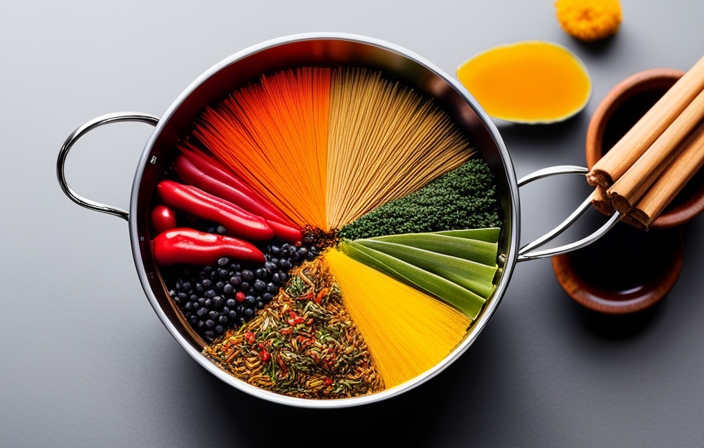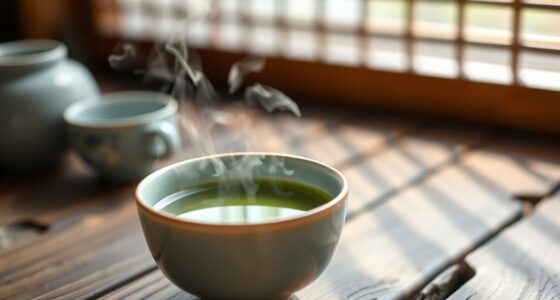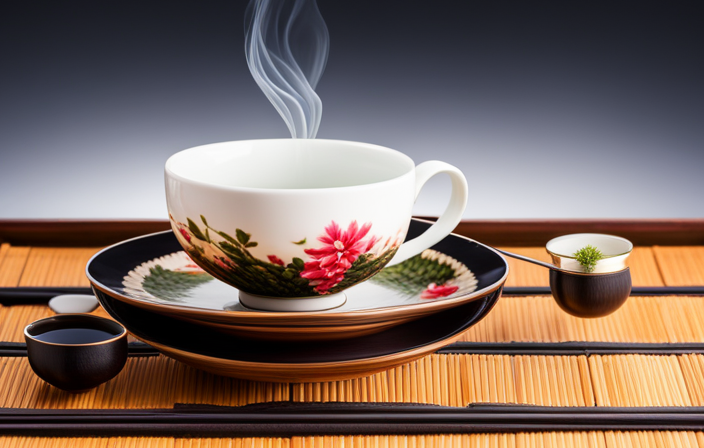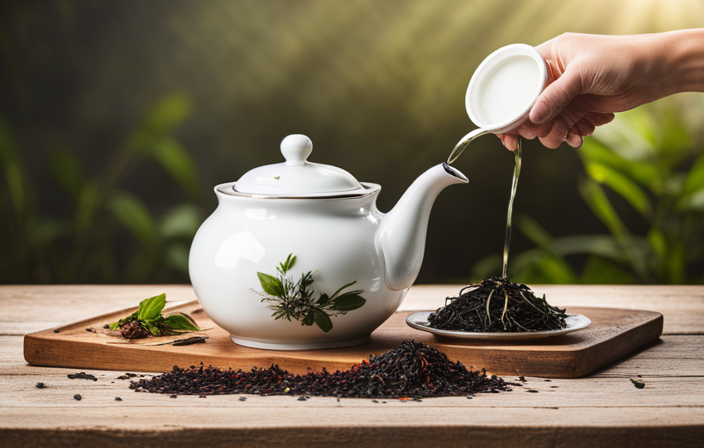Growing your own tea plant may seem like a daunting task, but with these 7 essential steps, it can be a rewarding and fulfilling endeavor.
From selecting the right tea plant variety to brewing and enjoying your homegrown tea, I’ll guide you through each step with practical advice and detailed instructions.
By following these steps, you’ll soon be savoring the taste of your very own handcrafted tea, ready to serve and delight others.
Let’s get started!
Key Takeaways
- Select the right tea plant variety based on your preference and climate.
- Create the ideal growing environment by providing well-drained soil, partial shade, and consistent moisture.
- Practice proper care and maintenance, including regular pruning, pest control, and sanitation.
- Learn the different harvesting and processing techniques for each type of tea to develop the desired flavor profile.
Selecting the Right Tea Plant Variety
I’m researching the best tea plant variety to grow in my garden.
When selecting a tea plant variety, it’s important to consider the soil requirements. Tea plants thrive in well-drained, acidic soil with a pH level between 4.5 and 6. To ensure optimal growth, amend the soil with organic matter like compost or leaf mulch to improve its fertility and drainage.
Choose a location that receives partial shade, as tea plants prefer indirect sunlight. Some popular tea plant varieties to consider are Camellia sinensis sinensis and Camellia sinensis assamica. The former is known for producing high-quality green and white teas, while the latter is more suitable for black and stronger teas.
Preparing the Ideal Growing Environment
To ensure optimal growth of my tea plants, I’ll prepare the ideal growing environment by amending the soil with organic matter and providing partial shade. Container gardening is a great option for growing tea plants, as it allows for better control over soil conditions and temperature. Start by selecting a suitable container that’s at least 12 inches deep and has good drainage. Fill the container with a mixture of organic potting soil and compost, ensuring it’s well-drained yet retains moisture.
To provide nutrients to the plants, use organic fertilizers specifically formulated for tea plants. These fertilizers will promote healthy growth and enhance the flavor of the tea leaves. Additionally, tea plants thrive in partial shade, so place the container in a spot that receives 4-6 hours of sunlight a day.
With the ideal growing environment established, let’s move on to planting your tea plant.
Now that the soil is amended and the container is ready, it’s time to plant your tea plant.
Planting Your Tea Plant
When planting your tea plant, it’s important to ensure that you have the ideal growing conditions. Choose a location that receives partial shade and has well-draining soil.
Select the right variety of tea plant based on your climate and preferences.
Taking proper care and maintenance of your tea plant will ensure healthy growth and a bountiful harvest.
Ideal Growing Conditions
I always make sure to provide my tea plant with plenty of sunlight to thrive in its ideal growing conditions. Sunlight is crucial for the tea plant’s photosynthesis process, which helps them produce energy and grow.
Here are three essential factors to consider for the ideal growing conditions of your tea plant:
-
Temperature: Tea plants prefer a moderate climate with temperatures ranging between 65-85°F (18-29°C). It’s important to avoid extreme heat or cold as it can stress the plant and hinder its growth.
-
Soil: The tea plant thrives in well-draining acidic soil with a pH level between 4.5-6. Soil rich in organic matter, such as compost or peat moss, is beneficial for its growth.
-
Watering: Tea plants require regular watering to keep the soil consistently moist but not waterlogged. Avoid overwatering, as it can lead to root rot. Aim for watering your tea plant once or twice a week, depending on the weather conditions.
Choosing the Right Variety
After researching various options, I’ve decided to plant a Camellia sinensis var. sinensis, as it’s known for its ability to produce high-quality tea. When it comes to tea, there are various types of flavors to choose from, such as green, black, white, and oolong. Each type offers a unique taste profile and health benefits.
Growing tea plants indoors can be a rewarding experience, but it requires some careful attention. Here are a few tips to ensure success:
1) Choose a well-draining potting mix specifically formulated for acid-loving plants.
2) Provide ample sunlight or use grow lights to mimic natural sunlight.
3) Maintain consistent temperature and humidity levels.
4) Water regularly, keeping the soil moist but not waterlogged.
5) Prune and fertilize the plant as needed.
By following these tips, you can enjoy a thriving tea plant and have access to fresh, homegrown tea flavors.
Now, let’s move on to maintenance and care.
Maintenance and Care
To ensure the health and longevity of your tea plant, regular pruning and fertilizing are essential. Pruning helps promote new growth, maintain the desired shape, and prevent diseases. Here are three key pruning techniques to keep in mind:
-
Crown Pruning: Remove any dead or damaged branches from the crown of the plant. This allows for better airflow and sunlight penetration, reducing the risk of fungal infections.
-
Tip Pruning: Trim the tips of the branches to encourage lateral growth and bushier foliage. This helps create a fuller and more compact plant.
-
Thinning: Remove any overcrowded or crossing branches to maintain an open structure. This allows for better light distribution and reduces the risk of pests and diseases.
In addition to pruning, providing adequate care and maintenance includes following a consistent watering schedule. Tea plants prefer moist but well-drained soil, so water deeply and allow the top few inches to dry out before watering again.
Providing Adequate Care and Maintenance
To ensure the healthy growth of your tea plant, it’s crucial to provide adequate care and maintenance.
Pruning is essential for removing dead or damaged branches, promoting air circulation, and encouraging new growth.
Additionally, implementing effective pest control measures and prevention strategies will help protect your tea plant from common threats such as aphids, mites, and fungal diseases.
Pruning for Healthy Growth
I should prune my tea plant every three months to ensure healthy growth. Pruning not only helps in maintaining the shape and size of the plant but also promotes healthy foliage.
Here are some essential pruning techniques that can be beneficial for your tea plant:
-
Remove dead or damaged branches: Trim any branches that are no longer producing leaves or have been affected by diseases or pests. This will prevent further spread and encourage new growth.
-
Maintain airflow: Prune densely growing branches to allow proper airflow through the plant. Good air circulation reduces the risk of fungal diseases and keeps the plant healthy.
-
Shape the plant: Trim the plant to maintain a desired shape and size. This not only enhances the aesthetics but also helps in providing adequate sunlight to all parts of the plant.
Pest Control and Prevention
I take necessary steps to prevent pests by regularly inspecting my tea plant and implementing proper maintenance techniques. As an avid tea grower, I understand the importance of keeping my plants healthy and free from pests.
Natural remedies and organic pesticides are my go-to solutions for pest control and prevention. One effective method I use is neem oil, which acts as a natural insect repellent. I dilute it with water and spray it on the leaves, ensuring complete coverage.
Additionally, I regularly prune my tea plant to remove any dead or diseased leaves, as they can attract pests. Proper sanitation practices, such as removing fallen leaves and debris around the plant, also help prevent pests from finding a home.
Pruning and Shaping Your Tea Plant
My tea plant’s branches are getting too long, so I need to start pruning and shaping it. Pruning is a crucial step in maintaining a healthy and productive tea plant. Here are three essential techniques to help you prune and shape your tea plant effectively:
-
Selective Pruning: Identify and remove any dead or diseased branches to prevent the spread of pests and diseases. Also, remove any weak or crossing branches to promote better air circulation and sunlight penetration.
-
Formative Pruning: Trim back the main branches to encourage lateral growth and bushier foliage. This will result in a more compact and attractive tea plant.
-
Maintenance Pruning: Regularly trim back excessive growth to maintain the desired shape and size of your tea plant. This will prevent it from becoming unruly and ensure a more manageable plant.
Remember to use sharp and clean pruning tools to avoid damaging the plant. Happy pruning!
Harvesting and Processing Tea Leaves
Harvesting and processing tea leaves requires careful timing and precise techniques to ensure the best flavor and quality. When it comes to harvesting, there are different techniques depending on the type of tea you are growing. For example, for green tea, the leaves are plucked when they are young and tender, while black tea requires mature leaves. To give you a better understanding, here is a table illustrating the different harvesting techniques for popular types of tea:
| Type of Tea | Harvesting Technique |
|---|---|
| Green Tea | Pluck young leaves |
| Black Tea | Harvest mature leaves |
| Oolong Tea | Partially fermented |
| White Tea | Pluck young buds |
Once the leaves are harvested, the processing stage begins. This involves withering, rolling, oxidizing, and drying the leaves. Each step is crucial in developing the desired flavor profile of the tea. The precise techniques used in processing can vary depending on the type of tea and the desired flavor. After the leaves are processed, they are ready for brewing and enjoying your homegrown tea.
Brewing and Enjoying Your Homegrown Tea
Once the leaves are processed, they’re ready for brewing, so I can’t wait to steep a cup of my homegrown tea and savor its unique flavors. Brewing your own tea isn’t only a rewarding experience but also allows you to enjoy the numerous health benefits it offers.
Here are three essential brewing techniques to help you make the most of your homegrown tea:
-
Water temperature: Different teas require different water temperatures for optimal flavor extraction. Green and white teas are best brewed with water around 175°F, while black teas and herbal infusions benefit from boiling water around 212°F.
-
Steeping time: The duration of steeping depends on the type of tea. Green and white teas generally require shorter steeping times, around 2-3 minutes, while black teas and herbal infusions can be steeped for 4-5 minutes.
-
Experiment with flavors: Don’t be afraid to get creative and experiment with different ingredients to enhance the flavors of your tea. Add lemon or mint for a refreshing twist, or try a dash of honey for a touch of sweetness.
Brewing your own homegrown tea isn’t only a delightful experience but also a way to enjoy the health benefits of tea in its purest form. So go ahead, steep a cup and savor the goodness!
Frequently Asked Questions
How Long Does It Take for a Tea Plant to Start Producing Leaves Suitable for Harvesting?
It typically takes around 2-3 years for a tea plant to start producing leaves suitable for harvesting. However, this timeframe can vary depending on various factors such as the specific tea variety, climate, and optimal growing conditions.
To ensure a successful harvest, it’s important to provide the tea plant with adequate sunlight, well-drained soil, regular watering, and proper pruning.
Can I Grow a Tea Plant Indoors or Does It Need to Be Grown Outdoors?
Growing a tea plant can be a rewarding experience, whether you choose to grow it indoors or outdoors. While tea plants are traditionally grown outdoors in suitable climates, they can also thrive indoors with the right conditions.
Indoor tea plants require ample sunlight, ideally from a south-facing window, and a consistent temperature between 65-85°F. It’s important to provide adequate humidity and well-draining soil for optimal growth.
With proper care and attention, you can enjoy your own homegrown tea leaves in no time.
How Often Should I Fertilize My Tea Plant and What Type of Fertilizer Should I Use?
When it comes to fertilizing my tea plant, I find that it’s important to strike a balance.
I typically fertilize my plant every two to three weeks during the growing season.
As for the type of fertilizer, I prefer to use organic fertilizers as they provide nutrients in a natural and sustainable way.
However, synthetic fertilizers can also be effective if used sparingly.
It’s essential to read the instructions on the fertilizer packaging and follow them carefully to ensure the best results.
Can I Use the Same Pruning Techniques for a Tea Plant as I Would for Other Plants?
When it comes to pruning techniques for a tea plant, I’ve learned that it’s not as simple as just using the same methods as other plants. Tea plants have their own unique growth patterns and requirements.
It’s important to understand how to properly prune a tea plant to promote healthy growth and maximize tea production. By following specific techniques tailored to tea plants, you can ensure a bountiful harvest and enjoy your very own homegrown tea.
Are There Any Special Considerations I Need to Keep in Mind When Brewing Tea From Homegrown Leaves?
When brewing tea from homegrown leaves, there are a few special considerations to keep in mind.
First, the brewing technique can greatly affect the flavor profile of the tea. Whether you choose to steep the leaves in hot water or cold brew them, it’s important to experiment and find the method that brings out the best taste.
Additionally, the quality of the leaves and how they’re processed can also impact the final result. So, pay attention to these factors to create a truly enjoyable cup of tea.
Conclusion
In conclusion, growing your own tea plant can be a rewarding and satisfying experience. By following the essential steps outlined in this article, you can successfully cultivate your tea plant and enjoy the fruits of your labor.
So why not embark on this journey and create your very own tea oasis? Imagine sipping a soothing cup of tea, knowing that it was grown and harvested right in your own backyard.
So why wait? Start growing your tea plant today!










